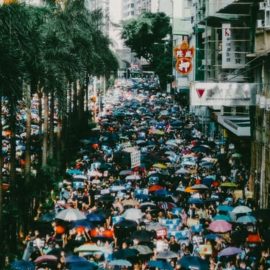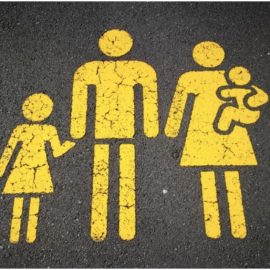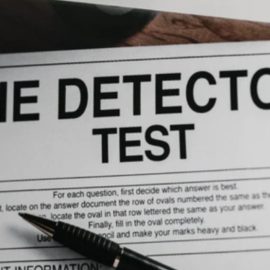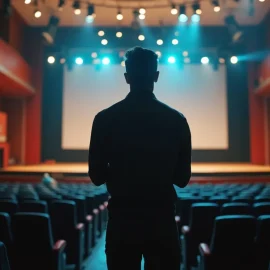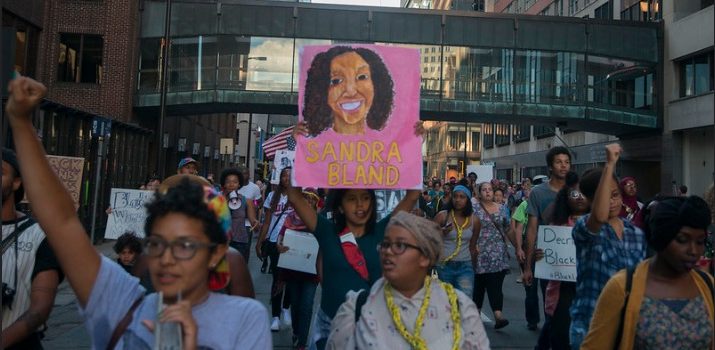
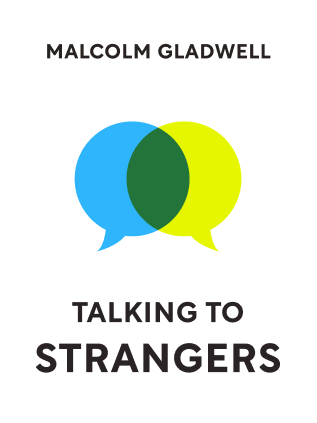
This article is an excerpt from the Shortform book guide to "Talking to Strangers" by Malcolm Gladwell. Shortform has the world's best summaries and analyses of books you should be reading.
Like this article? Sign up for a free trial here .
What happened to Sandra Bland? What events led up to death in jail? Who’s to blame? The police officer? The justice system? Our society as a whole?
We’ll cover Malcolm Gladwell’s answer to the question, What happened to Sandra Bland?, from his book Talking to Strangers. Learn why Gladwell thinks the death of Sandra Bland was the tragic result of common misreadings of strangers.
What Happened to Sandra Bland?
On July 10, 2015, a young woman named Sandra Bland was pulled over in a small town in Texas. She was a tall, beautiful, African American woman who liked to post inspirational videos online. She had just gotten a new job at Prairie View A&M University, and she had big plans to work while studying for her master’s degree. That day, just blocks away from her new campus, Sandy was pulled over for neglecting to signal a lane change.
The police officer’s name was Brian Encinia. His interaction with Sandra Bland began courteously enough. But after a few minutes, Sandra lit a cigarette and the officer asked her to put it out. She refused, and the interaction dissolved from there. What happened to Sandra Bland?
Brian Encinia told Sandra Bland to step out of the car. She repeatedly said no, telling the officer that he had no right to ask that of her. Eventually, Encinia began to reach into the car and try to remove Sandra by force. Finally, Sandra stepped out of her vehicle. She was arrested and put in jail, where she committed suicide three days later.
Sandra Bland’s death came at a time in American history in which police brutality against African Americans became particularly frequent and high-profile in the media. Michael Brown, Freddie Gray, Philando Castile, and Eric Garner—these are just a few of the names of African Americans that died as a result of police brutality. The Black Lives Matter movement began in that time frame. Sandra Bland even made a video urging African Americans and white Americans to find peace and understanding with each other. Three months later, Sandra was found dead in jail. What happened to Sandra Bland?
This book is an attempt to understand what really happened between Brian Encinia and Sandra Bland that day. We will come back to this particular interaction—between a white, armed, male police officer and a black, unarmed, female civilian—to question how it might have ended differently if only our society was better at making sense of strangers.
Sandra Bland’s arrest and subsequent suicide in jail is a tragic example of what can happen when two strangers use flawed strategies to try and understand each other. After Bland’s suicide, Brian Encinia was fired on the grounds that he did not conduct himself with courtesy and patience, as required by the Texas State Trooper Manual. But the case is about much more than that.
Everything that happened between Brian Encinia and Sandra Bland happened because Encinia behaved exactly as he was trained to—by police officials and society as a whole. This is what happened to Sandra Bland.
Brian Encinia’s Mistakes
Broken Default to Truth
At 4:27 p.m. on July 10, 2015, Brian Encinia noticed Sandra Bland go through a stop sign on campus. He was unable to legally pull her over at that time because the campus was outside his jurisdiction. So he drove up behind her to get a better look—to see if she had any signs of potential criminal intentions, like air fresheners or fast food wrappers. When Sandra Bland saw the police car behind her, she pulled over to let him pass. She unknowingly gave Encinia a lawful excuse to pull her over. She was pulled over for neglecting to signal her lane change.
When Encinia approached Bland’s vehicle, he saw a couple of small things that triggered him to doubt her:
- She had Illinois license plates which caused him to question her reasons for being in town.
- Bland had fast food wrappers in the car (because she had just driven all the way from Chicago to Texas).
Brian Encinia was taught, through his post-Kansas City police training, not to default to truth. He was taught to treat everyone like a suspect. And (because the cost of not defaulting to truth is to have mistrusting social interactions) Encinia was immediately scared of Sandra Bland because her license plate and food wrappers had already triggered his doubts.
Assumption of Total Transparency
When Brian Encinia approached Sandra Bland’s car on the passenger side, he immediately noticed that she was upset. Remember, Encinia was trained to assume transparency in people. So when Sandra Bland acted irritated and defensive, Encinia automatically began to assume the worst. In his testimony, Encinia said that he “immediately” knew that there was something “wrong” about Bland, based on her demeanor. He felt afraid that she was “aggressive,” and even suspected she might have a gun.
Sandra Bland was mismatched—she was an innocent driver who behaved in ways that Brian Encinia believed to indicate criminal intention. But he never stopped to consider that she was innocent because his assumption of transparency was ingrained through his police training. These assumptions would fatally contribute to what happened to Sandra Bland.
Neglect of Coupled Behaviors
In a single day on the job, Encinia often pulled over as many as 15 drivers in Prairie View, Texas for small infractions, like failure to signal a lane change. In fact, he had stopped three other drivers in the 30 minutes before he pulled over Sandra Bland. His post-Kansas City police training taught him that more stops would mean less crime. But remember, Sherman’s experiment showed that the needle-in-a-haystack approach only works when it is focused on particular contexts, like high-crime areas or gun ownership.
The area of Prairie View where Brian Encinia pulled Sandra Bland over was not a high-crime environment. Although Encinia said in his testimony that he had come across drugs and weapons in that area, his record shows that to be untrue. Lawrence Sherman himself was horrified that an officer would pull over a driver in that location, in the middle of the day, when the likelihood of crime was so low.
Likely, Encinia never stopped to think that the context of location and time could be coupled with the likelihood of crime, and he hadn’t been taught to think this way. Not paying attention to context was part of what led to what happened to Sandra Bland.
Sandra Bland’s Context
There are several things about Sandra Bland’s context that affected her behavior in the interaction with Brian Encinia and led to what happened to Sandra Bland:
- Sandra Bland had a history of emotional instability: Just a year before the incident with Encinia, Bland had attempted suicide after losing a baby. She had numerous scars on her arms, indicating that she often cut herself.
- Bland had a negative history with police officers: In her adult life, Sandra had at least 10 encounters with the police, including five traffic stops, which left her with $8,000 in fines.
- Bland was in a completely new environment: Sandra had just moved to a new state, started a new job, and enrolled in school. But, in the midst of this new beginning, she gets pulled over—which brings back memories of past encounters with the police.
Without getting to know Sandra Bland, Brian Encinia had no way to know how much of an emotional crisis Bland was going through during their interaction and her following days in jail. And because he had the false confidence of someone who has been trained to assume transparency, Encinia assumed that her upset behavior was evidence of sinister intentions.
Society’s Collective Mistakes
So, what happened to Sandra Bland? The death of Sandra Bland was not just a case of a bad police officer, or even a defective police department—it was a collective failure of our society. Everyone that Brian Encinia ever came across, in the police force or otherwise, operated with the same flawed strategies for making sense of strangers. Too few people have ever challenged those strategies or tried to replace them.
In our modern, seemingly borderless world, we have no choice but to interact with strangers. Yet we, as a society, are incompetent at making sense of the strangers we come across. So what should we do about it?
If our society is to avoid tragic interactions like what happened to Sandra Bland, we must learn to:
- Stop penalizing people for the human instinct to default to truth (like the leadership team of Penn State University was penalized for not suspecting Sandusky sooner).
- Remember that assuming honesty in another person is critical for human survival (or you could end up like Harry Markopolos, too paranoid to have a meaningful social interaction).
- Accept the limits of our ability to know the truth about another person (like Mitchell and Jesson should have done when they failed to listen to Charles Morgan about the dangers of interrogating KSM).
- Understand that there is no perfect strategy for interpreting a stranger’s thoughts and intentions (even the CIA’s best agent can’t always identify a spy in his midst).
- Be careful and attentive when speaking to a stranger (don’t assume transparency or penalize mismatched individuals like Amanda Knox).
Most importantly, we must learn not to blame the stranger when an encounter goes awry, but to look into how our own instincts might have played a part, as well.

———End of Preview———
Like what you just read? Read the rest of the world's best book summary and analysis of Malcolm Gladwell's "Talking to Strangers" at Shortform .
Here's what you'll find in our full Talking to Strangers summary :
- Why we don't understand strangers
- How to talk to strangers in a cautious way so you don't get fooled
- How Hitler deceived so many world leaders

